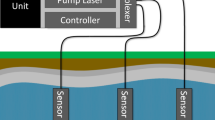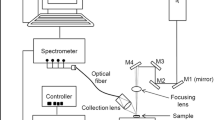Abstract
The success of carbon capture and storage (CCS) programme relies on the long-term isolation of CO2 from the atmosphere. Therefore, technologies concomitant to physical storage of CO2 such as reliable measurement, monitoring, and verification (MMV) techniques are needed to ensure that the integrity of the storage site is maintained. We propose the use of laser-induced breakdown spectroscopy (LIBS) analytical technique to detect carbon dioxide leaks to aid in the successful application of CCS. LIBS has a real-time monitoring capability and can be reliably used for the elemental and isotopic analysis of solid, liquid, and gas samples. The flexibility of probe design and use of fibre optics make it a suitable technique for real time measurements in harsh conditions and at hard-to-reach places. Proposed monitoring with LIBS includes terrestrial soil samples, water samples from monitoring wells or from different formations, air samples from monitoring wells or suspected leakage areas. This work details the laboratory scale experiments to measure carbon contents in rock, soil, aqueous, and air samples. The potential of the technology for measurements in high pressure high-temperature conditions will also be discussed.




Similar content being viewed by others
References
S Solomon, D Qin, M Manning, Z Chen, M Marquis, K B Averyt, M Tignor and H L Miller (eds), Contribution of working group I to the fourth assessment report of the intergovernmental panel on climate change (Cambridge University Press, Cambridge, United Kingdom and New York, NY, USA, 2007) p. 996
2010 Carbon Sequestration Atlas of the United States and Canada, Third Edition (Atlas III), http://www.netl.doe.gov/technologies/carbon_seq/refshelf/atlasIII/
R Lal, Forest Ecology Management 220, 242 (2005)
R Lal, Soil Tillage Res. 43, 81 (1997)
R Lal, Prog. Environ. Sci. 1, 307 (1999)
M Z Martin, N Labbe, N Andre, R Harris, M Ebinger, S D Wullschleger and A A Vass, Spectrochim. Acta Part B 62, 1426 (2007)
C D Farrar, M L Sorey, W C Evans, J F Howle, B D Kerr, B M Kennedy, C Y King and J R Southon, Nature 376, 675 (1995)
K A McGee and T M Gerlach, Geology 26, 463 (1998)
R J Gehl and C W Rice, Clim. Change 80, 43 (2007)
Z Sulcek and P Povondra, Methods of decomposition in inorganic analysis, 1st edn (CRC Press, Boca Raton, 1989)
K K Ayyalasomayajula, F Y Yueh, J P Singh, D L McIntyre and J Jain, Appl. Opt. 51, B149 (2012)
M Lawrence-Snyder, J Scaffidi, S M Angel, A P M Michel and A D Chave, Appl. Spectrosc. 60, 786 (2006)
A P M Michel, M Lawrence-Snyder, S M Angel and A D Chave, Appl. Opt. 46, 2507 (2007)
V N Rai, F Y Yueh and J P Singh, Appl. Opt. 42, 2094 (2003)
A P M Michel and A D Chave, Appl. Opt. 47, G131 (2008)
M Lawrence-Snyder, J Scaffidi, S M Angel, A P M Michel and A D Chave, Appl. Spectrosc. 61, 171 (2007)
Y K Kharaka and J S Hanor, Deep fluids in the continents: I. Sedimentary basins, Treatise on geochemistry, J I Drever (ed), Heinrich D Holland and Karl K Turekian (ex. eds) (Elsevier, 2003) Vol. 5, pp. 499–540, ISBN: 0-08-043751-6
K J Breen, C G Angelo, R W Masters and A C Sedam, U.S. Geological Survey: Water Resources Investigation Report (84-4314), Ohio Department of Natural Resources, Division of Oil and Gas (Columbus, OH, 1985)
A J Ball, V Hohreiter and D W Hahn, Appl. Spectrosc. 59, 348 (2005)
M Tran, B W Smith, D W Hahn and J D Winefordner, Appl. Spectrosc. 55, 1455 (2001)
E D McNaghten, A M Parkes, B C Griffiths, A I Whitehouse and S Palanco, Spectrochim. Acta B 64, 1111 (2009)
K E Eseller, F Y Yueh and J P Singh, Appl. Phys. B 102, 963 (2011)
F Ferioli, P V Puzinauskas and S G Buckley, Appl. Spectrosc. 57, 1183 (2003)
V Hohreiter and D W Hahn, Anal. Chem. 77, 1118 (2005)
V Dikshit, F Y Yueh, J P Singh, D L McIntyre, J C Jain and N Melikechi, Spectrochim. Acta B (2012), DOI:10.1016/j.sab.2012.01.009
D A Cremers, M H Ebinger, P J Unkefer, S A Kannerdiener, M J Ferris, K M Catlett and J R Brown, J. Environ. Qual. 30, 2202 (2001)
Author information
Authors and Affiliations
Corresponding author
Rights and permissions
About this article
Cite this article
JAIN, J., MCINTYRE, D., AYYALASOMAYAJULA, K. et al. Application of laser-induced breakdown spectroscopy in carbon sequestration research and development. Pramana - J Phys 83, 179–188 (2014). https://doi.org/10.1007/s12043-014-0788-4
Published:
Issue Date:
DOI: https://doi.org/10.1007/s12043-014-0788-4




